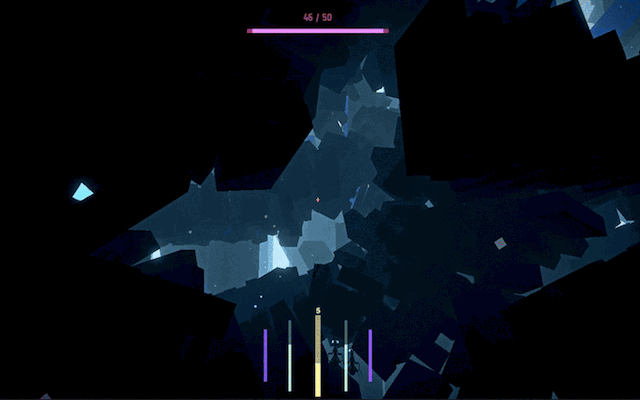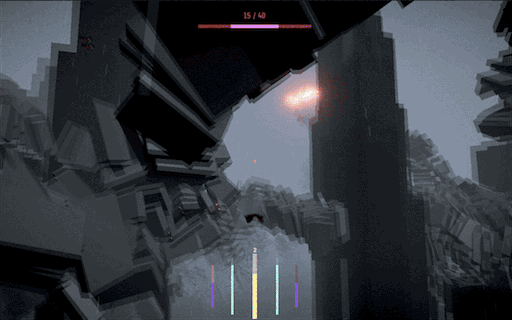Why Use GIFs?
As indie developers more often then not it falls to us to market and promote our own games. There are many ways to do this but one of my favorite is to use animated GIFs. Video games are an art form of moving images (mostly!) and if a picture is worth a thousand words an animated GIF is worth 80 to 100 thousand words.
Seeing your game in motion is a great way for people to get an idea about what it will be like to play it. I’ve found that the amount of interaction and interest I’ve gotten for my game Monarch Black on social media has increased the most at two key points: The first was when I started participating in the #screenshotsaturday hashtag on Twitter posting still images, and the second was when I switched to regularly posting animated GIFs, instead of stills.
Twitter is a great place to post GIFs but they’re also great for development forums like TIGSource’s Dev Logs area or your own dev blog. When people are scanning a feed or thread, the great thing about GIFs is that they automatically start playing, and looping as the user scrolls past. This gives your game a chance to reach new players that weren’t keen enough to click through a YouTube link, but might become interested seeing your GIF at a glance. In a conversation on Twitter with Jonathan Holmes of Destructoid he suggested to me that a simple email with a nice GIF embedded in it might be a good way to quickly capture a writers attention, and get them to click on further links to learn more.
For players and press, there’s very little friction in viewing a GIF. You know it’s going to be short, you don’t have to wait through ads and you can instantly see some piece of a game.

Easy Tools
There are a number of simple tools like Gyazo and GifCam which may be all that you need, depending on how involved you want to get. Both of these are stand alone applications designed to allow you to record things on your screen and output directly to GIF. What they lack in complex features or output quality they make up for in ease of use.
Visual Snacks
Now a little piece of advice. It’s possible to get very fussy about creating perfect, beautiful GIFs of your game but I would advise that this is a mistake. There are places for trying to make things perfect and beautiful, like in your trailer. The trailer is a piece of content that will be used in many places, hopefully seen by many people and will be a key selling tool for your game. The fun thing about GIFs is that they are ephemeral and a bit disposable. They’re like little visual snacks that you can sprinkle into your promotional efforts for your game.I think this is a strength of them as a medium and therefore instead of obsessing over quality you should focus on quantity.
Work Flow
This is where work flow comes in. Making and sharing GIFs, especially if you obsess over them, can be surprisingly time consuming. When you’re a one man band like me you want the time consuming thing you do to be making your game more awesome, not tweaking GIF compression. So! Here is a work flow that I’ve found works for me and allows me to produce the quality of GIF I want and seed them into the world.
Capture
First, I capture HD footage of my game using Open Broadcaster Software. OBS is an awesome tool. It captures great looking footage, allows you to stream on Twitch if you want to and is FREE. Tough to beat. I’ve used other capture packages like Screenflow (Mac only) and while it can be nice to have editing functionality in your capture software I’ve since switched over to using OBS and a Non Linear Editing (NLE) package instead. In this case because I have an Adobe Creative Cloud subscription I’m using Adobe Premiere for video editing.The settings I use to capture in OBS (which aren’t super important, but I’ll share for completeness sake) are as follows:
- Mode: File Output Only
- Resolution: 1920 x 1080
- Max Bit Rate (kb/s): 8000
I’ve gotten in the habit at the end of a dev session to make a build of the game and capture myself playing for half an hour or so. This has a few benefits. First, I’m capturing high quality video footage regularly which I could use in other video content (like a new trailer I’m planning to cut soon). Second it forces me to play the game differently and focus more on playing and less on bug seeking and note taking. Third it gives me lots of material for GIFs!

Once I’ve got my footage captured I drop it in my NLE, in this case Premiere. I then go through the captured footage and find five or six nice moments that show new features, look good or whatever my goal for the GIFs are. I mark in and out points and then export this directly to GIF using Premiere’s Animated GIF export option.
The most important venue for my own GIF output thus far has been Twitter so it’s important to make sure that any GIFs I am authoring can be posted there, along with wherever else. This means that I want all of the GIFs I am creating to be between 3 and 4 MB in file size. The variables that we have to tune are resolution, frame rate and image quality. It’s important to note that depending on the visual content of your game your mileage may vary but I’ve found a sweet spot with the following settings in Premiere.
- Length: Under 5 seconds (usually aim for 4 seconds 20 frames)
- Resolution: 500 x 280 or 400 x 300 (which results in letterboxing, see below)
- FrameRate: 20
- Field Order: Progressive
- Aspect: Square Pixels
This generally results in a GIF that’s around 3.8MB give or take which I find gives me a nice balance of quality to file size.
I’m currently doing this on Windows. My understanding (correct me if I’m wrong!) is that the Animated GIF export option is not available on Premiere on OS X. On Mac I’ve gotten very good results using GIF Brewery. GIF Brewery actually has more control over the output and allows you to tune the compression and get it looking better. I found this lead me to obsess over tweaking it which slowed down my output a bit, and my main dev machine is a Windows box which is why I shifted over to my current workflow. GIF Brewery is a great option though if you’re on Mac. I learned about it from a tip from Justin Pierce on Twitter, and he’s actually done a good post comparing different compression settings with it on his blog.
Scheduling and Posting
The last bit of the workflow is posting them to Twitter. Of course this can be done using the regular Twitter web client, but I’ve found that using Tweetdeck has a few advantages.
The main advantage is that you can schedule GIF posts. I love this since being consistent about posting things regularly is hard when you’re working on your game or taking care of the rest of your life. This allows me to sit down, make a batch of new GIFs, set a posting schedule and then come back periodically to find a bunch of notifications (the Twitter ego equivalent of cocaine pellets for experimental rats). To schedule tweets on Tweetdeck first hit the compose button, add your image (do this before writing so you know your available character count), compose your message, add your hashtags, and then instead of hitting the ‘Tweet’ button, press ‘Schedule’ and choose a date and time. It’ll appear in a Tweetdeck column showing when it’s scheduled to go out on the right. Don’t worry if later scheduled tweets don’t show the GIF preview, it’s there.

As far as hashtags to post to I like #screenshotsaturday, #gamedev, #indiedev and #indiedevhour. The communities around those tags are generally very nice, supportive and happy to like and retweet your stuff if they dig it. These tags are public free spaces so please don’t spam them or abuse them! I won’t put forward a rate for how often you should post to them but I do see people setting up armies of bots all tweeting the same thing in there and I block them. Don’t be that guy (or girl, or bot). Also, if you’re using those tags, retweet and like some of the cool stuff you see! I’ve met a lot of interesting people online just cruising those tags and helping to signal boost other people’s stuff, and other people have done the same for me.
Questions?
Hopefully this has been helpful for you! If you found it useful or have questions feel free to hit me up on Twitter, I’m @mattmirrorfish. The GIFs in this post are from my game Monarch Black which is currently in development. You can learn more about it at my website, mirrorfishmedia.com